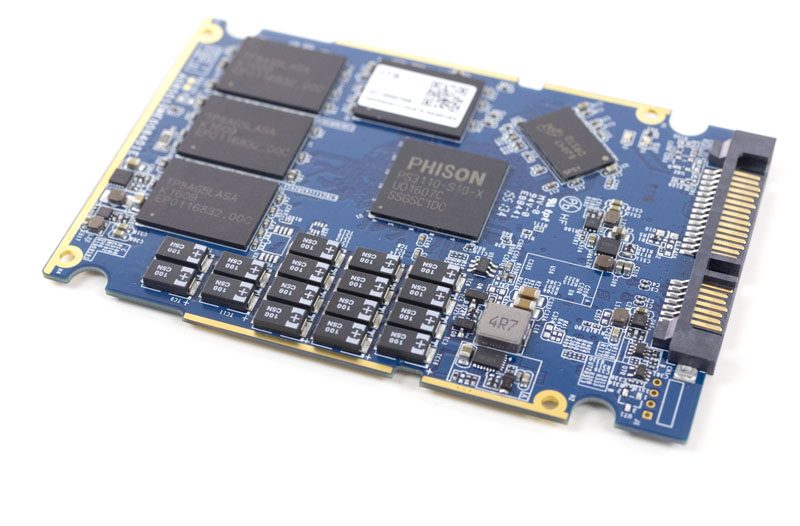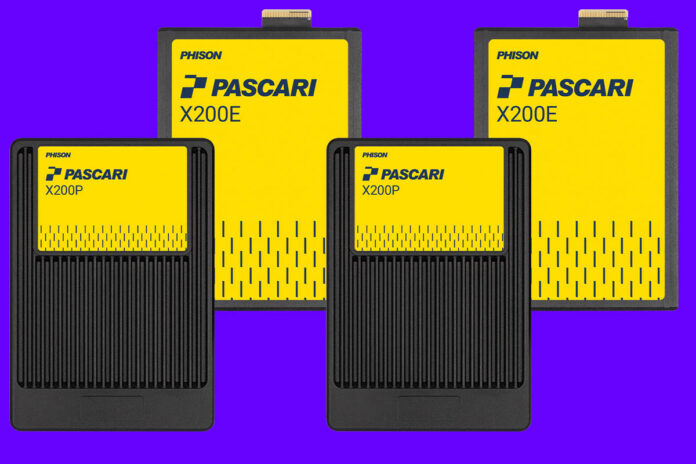Today Phison is launching not just a new SSD, but an entirely new SSD brand. The Pascari brand will be Phison’s data center SSD brand that it sells into the market. From the new brand, we get the Pascari X200 a PCIe Gen5 NVMe SSD designed for the data center market. There is a lot to unpack here, so let us get to it.
Phison Pascari X200 PCIe Gen5 NVMe SSD
The new X-series drive is part of Pascari’s performance line. The X200 is a U.2 / E3.SSD ranging from 1.6TB to 30.72TB in capacity and 1 or 3 DWPD of endurance. Sequential read/ write is rated at 14.8GB/s / 8.7GB/s. The drives offer up to 3M 4K random read IOPS and 900K random write. They also feature features like power-loss protection. While the brand may sound new to many, remember we did a piece getting ~1M IOPS using 24 Phison data center SATA SSDs in 2016. Now one can get more capacity and performance in a single drive.

Beyond the Pascari X200 series of performance NVMe drives, the company will have an AI series, M.2 and E1.S D-series NVMe SSD line, a SATA S-series of 2.5″ SSDs, and a boot drive B-series in U.2 and E1.S form factors.
Final Words
Over the past few years, Phison has garnered a huge portion of the SSD controller market. Even with the background of multiple large semiconductor companies making merchant SSD controllers, some NAND makers making their own controllers, and controllers being built for certain geographic markets, Phison is thriving. From what we have heard, it has over 20% of the SSD controller market, and its controllers are found in some big name brand SSDs. The company now employs over 2800 engineers for some sense of scale. Just to put the X200 into perspective, there are large NAND manufacturers that have SSD lines that do not include PCIe Gen5 NVMe SSDs even today.
At the same time, this will create some chaos. Phison is now competing with some of its customers. Inevitably, that causes issues in relationships. It will be interesting to see how that shapes the market over the coming quarters. Still, for Phison, the BOM cost for a modern data center SSD is dominated by the NAND content. As a result, selling a completed SSD (which the company has done for years as an OEM/ODM model) generates a lot more revenue per SSD than selling just the controller.
Hopefully, we get the X200 soon.




For anyone interested TechPowerUp published the entire presentation deck of this announcement. It contains some interesting specifications including long term plans like 122TB “U.2 pro” models.
I’m disappointed they weren’t even mentioned here.
Is it known whether the announcement of own-brand drives means that their willingness to do OEM/ODM is changing; or will they continue to do that, for anyone who meets some minimum order quantity and wants their own SSD line with minimal engineering effort; but will also be slapping their own sticker on some percentage of the OEM drive output and selling it directly?
I’d assume that those customers wouldn’t be thrilled, since they’d prefer an ODM that is content to sit in the background and accept relatively low margins so that the badge-engineering brands can get a slice; but it would be considerably more disruptive if they are actually pulling the plug on the ability to get Phison SSDs ODM-ed for you to fill out a product line.
As for the “selling a completed SSD generates a lot more revenue” angle; does Phison have any particular advantages(beyond being a decent size customer) that would help them get particularly good prices on NAND; or will they be juicing revenue but not margins vs. controller sales?
fff, I don’t really see Phison’s own datacenter-centric brand causing concern for, say Sabrent and their consumer-focused line of drives, like the 2242 for Lenovo Legion Go, or PS5-specific stuff.
Question : by any chance, and since the S10 is already from 2016 (the pic caught me on the wrong foot ps3110-s10-x!), will this drive also use the Andes Technology N25F Risc-V processor (PS5020-E20) used in the Phison’s X1 Enterprise SSD Controller?
=> https://youtu.be/f6mPK3QCrBo?t=333
Just curious vis-à-vis WD concerning usage of embedded Risc-V usage.